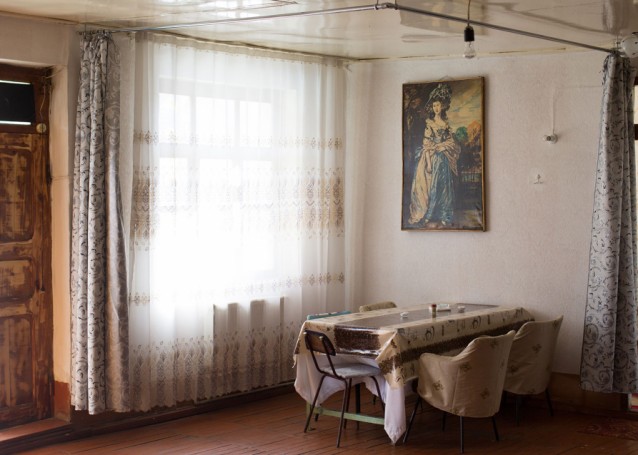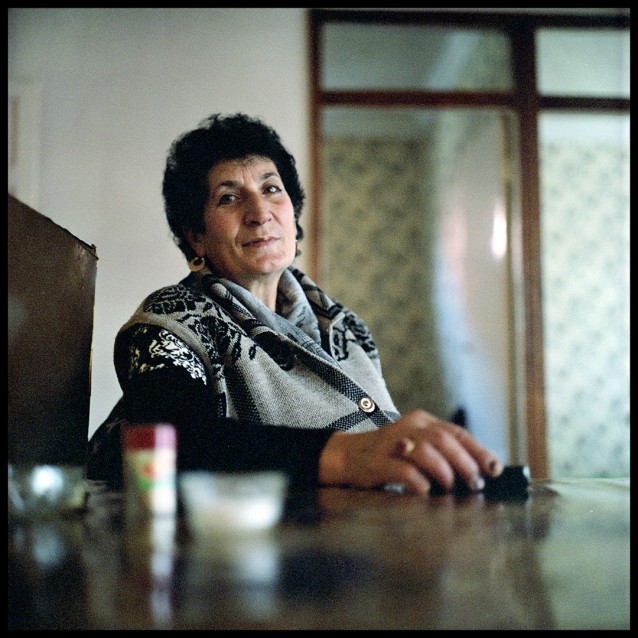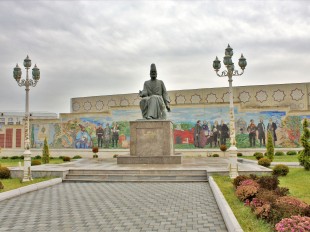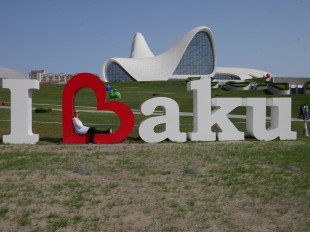In the cold winter of 1818 a column of tired Swabian German emigres came to a welcome halt in Ganja, then the capital of the Elizavetpol region of the Russian Empire. Escaping famine and political unrest back home, the Germans settlers had taken up the Russian Tsar’s offer of settling in the South Caucasus. The following spring they moved some 10 km south and founded the colony of Helenendorf, and over the following 100 years developed a thriving community fuelled by a bustling wine industry. But in 1941 this seemingly idyllic scene came to a sudden and tragic end as shortly after the Soviet Union entered the Second World War, almost all the Caucasus Germans were rounded up and deported to the far-off steppes of Kazakhstan.
During the war the German presence in Helenendorf was kept alive by a contingent of German POWs and in the ensuing years Azerbaijanis driven from neighbouring Armenia gradually moved into the old German homes. Helenendorf was renamed Khanlar and more recently, Goygol (after the stunning lake 30 km up the road). Soviet Khanlar was a hub of multiculturalism, a microcosm of the Soviet Caucasus – Azerbaijanis, Armenians, Georgians, Russians, Ukrainians... as well as the few mixed-race Germans that had been allowed to stay behind. The last of those was Victor Klein, considered Goygol’s last German, who died only a few years ago. His house is in the process of being turned into a museum, recounting the story of the Helenendorfers and the Caucasus Germans as a whole. But this isn’t the only place in the former colony to rekindle a sense of the past...
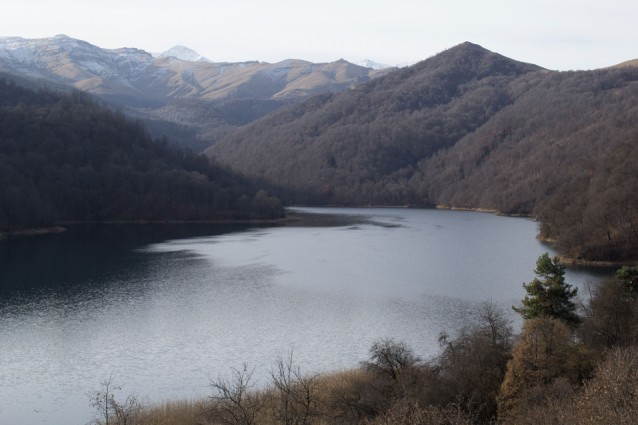 Lake Goygol, one of the most spectacular sites in the Ganja region. The Goygol National Park was closed for a number of years but reopened in 2015 and can now be easily visited. Photo: Tom Marsden
Lake Goygol, one of the most spectacular sites in the Ganja region. The Goygol National Park was closed for a number of years but reopened in 2015 and can now be easily visited. Photo: Tom Marsden
In praise of pork
I actually came across this unassuming establishment a few years ago during my first visit to the Ganja region. An artist I met in Goygol that day, Rufat, sang the praises of local restaurateur Larissa and off we went for a memorable meal. Larissa’s was cosy and its concept utterly unique, so I made a note to come back. When I finally return to Goygol in late November 2017, Larissa remembers me – you sat over there, she says – and is more than willing to share the story behind her unusual restaurant, whose culinary inspiration emanates from the old German colonists.
The Germans worked with pork, they consumed a lot of pork; they farmed pork, their main industry was pork: they did salceson, they did liver, ham, beef, veal – they did this. And our people adopted this from them, and now they aren’t here but after they left we kept pigs, cows, everything. It’s left over from them: red kolbasa (sausage – Ed.) is left from them, ham is left from them ... it’s all left over from them. I adopted all this from my parents, from my father-in-law.
Since she specialises in pork, Larissa works seasonally and her restaurant only functions during the winter (from 1 October to early April) when pork, like fish, is best consumed. The rest of the year she spends at her home just across the road preparing for the season ahead: pickling apples, plumbs, wild garlic and cabbage, making cheese and wine. She also has time to travel and visit relatives. The restaurant’s main dishes are sardelki (German sausages), pork chops and for those that don’t eat pork she always keeps cured veal. Customers therefore get an authentic taste of the past, albeit with Larissa’s own little twist:
The Germans made red kolbasa and smoked it, they hung it out, dried it and then smoked it, but we simply... I make it at home fresh, straightaway, and serve it to the table... I fry it on the mangal and serve to the table.
She proudly claims that hers is currently the only restaurant that does sardelki in Azerbaijan, as well as certain German pastries. Other than this German influence, her cuisine also takes elements from the lush surrounding countryside, its apples and pears. It was no coincidence that the Germans chose this particular area, she says, adding that she takes great pleasure from cooking natural, eco-friendly dishes, particularly when she sees the pleasure this gives her clients.
One of those is me and without further ado I don my Azerbaijani food critic cap (specialism in regional kebabs) and decide to put her words to the test. A large red sausage and pork chop arrive at the table, with a glass of fresh compote and homemade wine. Goygol is after all the birthplace of the Azerbaijani wine industry – You can’t come to Goygol and not drink, a local man later tells me as I draw breath at the sight of a bottle of samogon (homemade vodka) plonked on the dinner table. A tray of salads, basket of bread and some ajika sauce complete the set-up and as I get caught up in photographing all this Larissa hurries me along, stressing: you must eat it while it’s hot!
I would be lying to say I hadn’t missed a good sausage during my time in Azerbaijan and sure enough Larissa’s are seasoned and succulent, soothing my sausage-defficient taste buds. My knife then cuts effortlessly through the chops, which go down so smoothly with the cool, tomato-tinted ajika that I’m left wondering whether I ought to order another round. Each meat dish costs 4 AZN so one can eat well for 10-12 AZN overall.
Larissa’s or DLD
Laughter erupts from a party of clients from Baku lunching in one of the private rooms which are distributed around the restaurant’s central area with its casual, home-from-home feel. The homemade wine adds to the general warmth of the atmosphere, as does the fact that when not rushing between clients Larissa takes time to sit opposite me and elaborate on how she transitioned from housewife to restaurateur.
She tells me that the restaurant opened in 1990 amid the disturbances of the Karabakh conflict when the building became vacant and Larissa, living opposite, took the opportunity to open DLD, which stands for Dano Larissa David, the names of her father-in-law (first) and son (last), as well as her own. But most locals refer to the restaurant simply as “Larissa’s,” such is the character and presence of the host.
Larissa has lived in Goygol for 42 years but was actually born in Siberia where she spent all of seven days (yet still feels a strong spiritual connection to the region) before growing up in Aghstafa (in western Azerbaijan) and Georgia. The reason for all this wandering and another defining feature of the restaurant is Larissa’s ethnicity: she’s one of Goygol’s last Assyrians, a people well used to migration. Reluctant to reveal my ignorance, I nonetheless ask: Who are the Assyrians?
The Assyrians, you can check this afterwards on the internet, are a very ancient people. They came from Iraq, between the Tigris and the Euphrates, Mesopotamia.
Today, Larissa says, the Assyrians are scattered around the world but despite the obvious challenges they still manage to preserve their own language, faith, culture and traditions (for a sense of this type Assyrian Folk song from Azerbaijan into YouTube and watch a video of Larissa singing an Assyrian song). She praises current government policy towards small nations in Azerbaijan, as a result of which she feels more privileged than most Azerbaijanis.
Goygol today is home to only three Assyrian families but the picture was quite different a century ago. Having sided with the entente powers, a huge wave of them migrated from Turkey to the Caucasus during the First World War and many settled in the German colonies of Georgia and Azerbaijan, attracted to the German way of life. As Christians, the Assyrians and Germans also complemented each other on religious grounds – they always celebrated Christmas and Easter together, Larissa says. While the original Assyrian settlers were largely illiterate, as the younger generations began to socialise with the Germans, they became more cultured and educated. All those that lived with the Germans knew German, she says, adding:
They (the Assyrians – Ed.) learnt to do everything from them: to cook something tasty – from them; to boil soap – from them; to make klyotski (dumplings – Ed.) – from them; to make angel wings (pastries – Ed.) – also from them. We are the ones that adopted this from them.
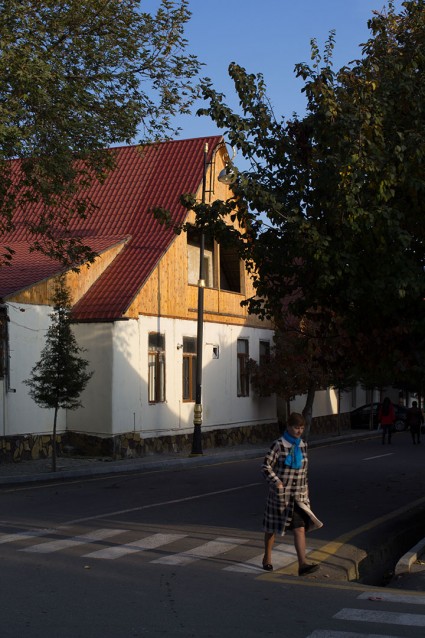 Despite the absence of descendants of the original settlers in Goygol today, the town has nonetheless preserved the charming old German-built streets and houses. Photo: Tom Marsden
Despite the absence of descendants of the original settlers in Goygol today, the town has nonetheless preserved the charming old German-built streets and houses. Photo: Tom Marsden
Goygol’s German legacy
Larissa’s tone of respect towards the original settlers is something I sense from many I talk to during my two days in Goygol. The Germans may have gone but the town hasn’t forgotten its founding fathers. Cuisine aside, I ask Larissa more broadly what she feels the German legacy is. She pauses momentarily and then says:
The German legacy is their culture; they say “cultured like a German,” these words are really emphasised: cleanliness, order. The Germans were very clean – they had order, precision, you see, they have this.
This, when added to the warm Azerbaijani hospitality I experience from several other of today’s Goygol residents – from Aydin and his family who host and feed me, and from Fikret muellim who guides me around Victor Klein’s house museum and invites me for dinner – is a winning recipe.
The old colony of Helenendorf, once Khanlar and now Goygol, is a unique corner of Azerbaijan. To experience the flavour of it, don’t forget to head to Larissa’s.
|
Getting there: Larissa’s is located at the top of Hummel Street in Goygol. If you have trouble finding it simply mention “Larissa” to any local and they’ll be able to point you in the right direction or even take you there. Goygol is easily reached from Ganja by taxi or bus. Buses go from the bottom of Ganja’s Nariman Narimanov Street and will cost you 20 qepiks; taxis can be found at the same spot and should cost from 4 AZN (be a little careful not to be ripped off!). |

